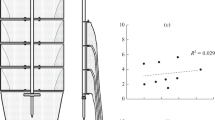Abstract
Various environmental parameters which may affect the activity ofGammarus pseudolimnaeus were examined in the laboratory. The animals' responses were monitored automatically using an ultraviolet beam interruption technique. The basic diel activity pattern in the fall showed high rates of drifting at night but in the summer showed uniform drift throughout the light/dark cycle. Upstream activity was greater in the summer when it compensated approximately 11% of the number of animals drifting downstream. A large-sized gravel substrate (31.5 mm diameter) produced significantly lower night-time drift than either a medium-sized gravel (11.0 mm diameter) or a small-sized gravel (3.4 mm diameter). Animals drifted more at current speeds of 5 to 15 cm/s than at 20 to 25 cm/s. The introduction of rainbow trout to the tanks in the day or night caused almost total cessation of drift and upstream activity within minutes. Trials with fish water suggested that the amphipods detect some form of labile exudate produced by the fishes. Additions of toxicants, in the form of sulphuric acid and NaCl, produced changes in activity levels before lethal concentrations were reached.
Similar content being viewed by others
References
Allan, J. D., 1978. Trout predation and the size composition of stream drift. Limnol. Oceanogr. 23: 1231–1237.
Bousfield, E. L., 1958. Freshwater amphipod crustaceans of glaciated North America. Can. Field-Nat. 72: 55–113.
Crowther, R. A. & Hynes, H. B. N., 1977. The effect of road deicing salt on the drift of stream benthos. Environ. Pollut. 14: 113–126.
Dennert, H. G., Dennert, A. L., Kant, P., Pinkster, S. & Stock, J. H., 1969. Upstream and downstream migrations in relation to the reproductive cycle and to environmental factors in the amphipod, Gammarus zaddachi. Bijdr. Dierk. 39: 11–43.
Holt, C. S. & Waters, T. F., 1967. Effects of light intensity on the drift of stream invertebrates. Ecology 48: 225–234.
Hultin, L., 1971. Upstream movement of Gammarus p. pulex (Amphipoda) in a south Swedish stream. Oikos 22: 329–347.
Hynes, H. B. N., 1955. The reproductive cycle of some British freshwater Gammaridae. J. Anim. Ecol. 24: 352–387.
Hynes, H. B. N. & Harper, F., 1972. The life histories of Gammarus lacustris and G. pseudolimnaeus in southern Ontario. Crustaceana 3: 328–341.
Kleerekoper, H. & Mogensen, J., 1963. Role of olfaction in the orientation of Petromyzon marinus. 1. Response to a single amine in prey's body odour. Physiol. Zool. 36: 347–360.
Marchant, R. & Hynes, H. B. N., 1981. The distribution and production of Gammarus pseudolimnaeus (Crustacea; Amphipoda) along a reach of the Credit River, Ontario. Freshwat. Biol. 11: 169–182.
Meijering, M. P. D., 1972. Experimental studies on drift and upstream and downstream movements of gammarids in running water. Arch. Hydrobiol. 70: 133–205.
Meijering, M. P. D., 1973. Quantitative Untersuchungen zur Drift and Aufwanderung von Gammarus fossarum Koch in einem Mittelgebirgsbach. Verh. Ges. Ökologie, Saarbrucken 1973, 143–147.
Minckley, W. L., 1964. Upstream movements of Gammarus (Amphipoda) in Doe Run Meade Country, Kentucky. Ecology 45: 195–197.
Müller, K., 1974. Stream drift as a chronobiological phenomenon in running water ecosystems. Ann. Rev. Ecol. System. 5: 309–323.
Peckarsky, B. L., 1980. Predator-prey interactions between stoneflies and mayflies: behavioural observations. Ecology 61: 932–943.
Rees, C. P., 1972. The distribution of the amphipod Gammarus pseudolimnaeus Bousfield as influenced by oxygen consumption, substratum, and current velocity. Trans. Am. Microsc. Soc. 91: 514–529.
Stein, R. A. & Magnuson, J. J., 1976. Behavioural response of crayfish to a fish predator. Ecology 57: 751–761.
Wallace, R. R., 1977. A discussion on the use of behaviour by Gammarus pseudolimnaeus Bousfield in evaluating environmental stress. Proc. 3rd Aquatic Toxicity Workshop, Halifax, N. S., Nov. 2–3, 1976. Environmental Protection Service Tech. Rep. No. EPS-5AR-77–1, Halifax, Canada, pp. 59–67.
Wallace, R. R., Hynes, H. B. N. & Kaushik, N. K., 1975. Laboratory experiments on factors affecting the activity of Gammarus pseudolimnaeus Bousfield. Freshwat. Biol. 5: 533–546.
Waters, T. F., 1962. Diurnal periodicity in the drift of stream invertebrates. Ecology 43: 316–320.
Waters, T. F., 1972. The drift of stream insects. Ann. Rev. Ent. 17: 253–272.
Williams, D. D., 1980. Temporal patterns in the recolonization of stream benthos. Arch. Hydrobiol. 90: 56–74.
Zar, J. H., 1974. Biostatistical Analysis. Prentice-Hall, Englewood Cliffs, N.J.
Author information
Authors and Affiliations
Rights and permissions
About this article
Cite this article
Dudley Williams, D., Moore, K.A. The effect of environmental factors on the activity ofGammarus pseudolimnaeus (Amphipoda). Hydrobiologia 96, 137–147 (1982). https://doi.org/10.1007/BF02185429
Received:
Issue Date:
DOI: https://doi.org/10.1007/BF02185429




